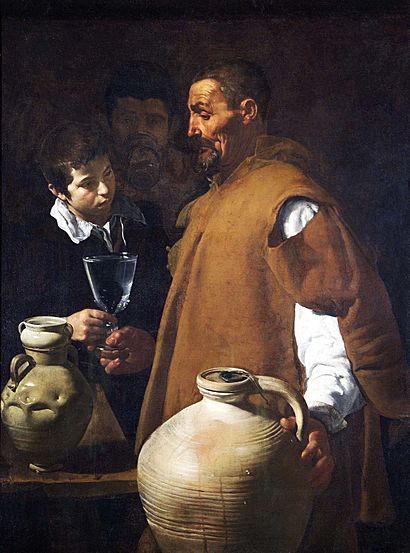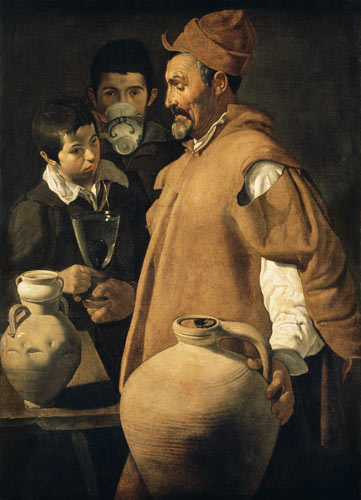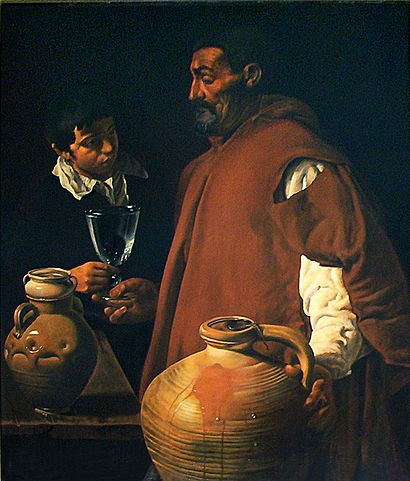The Waterseller of Seville facts for kids
Quick facts for kids The Waterseller of Seville |
|
|---|---|
 |
|
| Artist | Diego Velázquez |
| Year | 1618–1622 |
| Medium | Oil on canvas |
| Dimensions | 105 cm × 80 cm (41 in × 31 in) |
| Location | Apsley House, London |
| The Waterseller of Seville | |
|---|---|
 |
|
| Artist | Diego Velázquez |
| Year | 1618 |
| Medium | Oil on canvas |
| Dimensions | 104 cm × 75 cm (41 in × 30 in) |
| Location | Uffizi, Florence |
| The Waterseller of Seville | |
|---|---|
 |
|
| Artist | Diego Velázquez |
| Year | 1620? |
| Medium | Oil on canvas |
The Waterseller of Seville is the name of three famous paintings by the Spanish artist Diego Velázquez. He painted them between 1618 and 1622. The first and most well-known version is at Apsley House in London. It's considered one of his best works from when he lived in Seville. Velázquez was only in his late teens or early twenties when he created this painting.
In the painting, you see an older man, a young boy, and another person in the background. The old man is giving the boy a glass of water. Interestingly, none of the people in the painting look at each other. They also don't look out at the viewer.
Contents
History of the Painting
Art experts believe Velázquez painted The Waterseller of Seville just before he moved to Madrid. This painting is a type of art called a bodegón. A bodegón painting often shows everyday scenes, especially with food or drinks.
This painting is very simple. It uses only a few colors. Velázquez painted it in a realistic style. He focused on still objects and people, making them look very true to life. Some experts think this painting was not ordered by anyone. Velázquez might have painted it just because he wanted to.
What the Painting Shows
The main person in the painting is a waterseller. Selling water was a common job for poorer people in Velázquez's hometown of Seville. The large water pots and other items in the painting are typical of bodegón art.
The waterseller has two customers. One is a young boy. This boy might be the same model Velázquez used in his other paintings, The Lunch and Old Woman Cooking Eggs. The other customer is a young man in the shadows behind them. He is harder to see now, but he is clearer in the version of the painting in the Uffizi museum.
Details in the Foreground
In the front of the painting, you can see the seller's huge water pots. They look wet and shiny with water splashes. They are so big and round, they almost seem to come out of the painting. The seller is giving a freshly poured glass of water to the boy. Inside the glass, there is a fig. People used to put figs in water to make it taste fresher. This is still done in Seville today!
Setting and Lighting
We don't know for sure where the scene takes place. It might be inside or near a tavern. Light comes into the painting from the left side. This light makes the young boy and the water drops on the pot stand out. This shows how much detail Velázquez put into his paintings.
The Characters
The scene is very calm and still. This is a common feature in Velázquez's everyday scenes. The waterseller's face is very interesting. It looks thoughtful and has many wrinkles from age and sun. His short hair and simple clothes make him look like a wise person.
As mentioned before, the old man does not look at the young boy or the other man. He also doesn't look at the viewer. The young boy does the same. He doesn't look at the old man, and his back is to the other man. The boy also avoids eye contact with the viewer.
According to an old writer named Antonio Palomino, the old man in the painting was very sick. He had torn clothes and warts on his skin. The old man gives the young boy water, and the boy takes it without showing any thanks.
Meaning of the Painting
Velázquez showed respect for poor people in his art. He believed that simple, everyday actions could be as important as grand religious scenes. This means he painted even small gestures as if they were sacred.
The Waterseller shows how Velázquez was growing as an artist. His understanding of the waterseller's personality is like how he understood the people in his famous portraits. His careful way of painting small details shows how well he understood how people see things. In the painting, the old man and the young boy both touch the same glass. But they never look at each other. This could be because of their different social classes or their age difference.
Artistic Influences
Another artist who used a simple color range was Caravaggio. He greatly influenced this painting. Caravaggio painted saints as real, imperfect people, unlike the perfect figures of the Renaissance.
Just like Caravaggio, Velázquez did not make his subjects look perfect. Instead, he wanted to show them exactly as they were in real life. He captured the flaws in the seller's pots, the wetness on their sides, and the sparkle of light on the water drops. He also showed the true expressions of the people.
Francisco Pacheco was Velázquez's teacher and also his father-in-law. Pacheco praised Velázquez's bodegones paintings. He felt they were not getting enough recognition.
Antonio Palomino, who lived at the same time as Velázquez, was the first to write about this painting. He said the old man looked worse than he actually did. However, Palomino was sometimes wrong in his descriptions of Velázquez's paintings. He had also given an incorrect description of An Old Woman Cooking Eggs.
Different Versions of the Painting
Velázquez painted The Waterseller of Seville three times. Each version is a little different.
London Version
The most famous version of the painting is in Apsley House in London, United Kingdom. This painting was once part of the Spanish Royal Collection. It was kept in the Buen Retiro Palace and later the Palacio Nuevo.
During the Napoleonic Wars, Joseph Bonaparte stole it. But the Duke of Wellington won it back. He got it, along with 82 other paintings, at the Battle of Vitoria. The King of Spain let him keep the paintings because he had defeated the French. Wellington brought the painting to England, where it is today at Apsley House. You can see this version in the Waterloo Gallery at the museum part of the house.
Florence Version
The version in the Uffizi Gallery in Florence feels a bit more playful. The seller wears a fancy red hat. The man in the background is also easier to see. Some people think this version might have been painted before the London one.
This version is the least bright of the three. The pot doesn't shimmer like in the other two, and the colors are very pale. This might have been more like what people expected at the time. Watersellers were often shown as funny or tricky characters in popular stories.
Baltimore Version
The third version shows the waterseller in a different way. Here, he looks almost sad or even silly. The colors in this painting are the brightest of the three. The pots look very shiny. However, like the Florence version, the people in this painting don't seem to have as much personality as in the London version. The man who was in the background of the other paintings is gone. The background is dark, which makes the bright colors in the front, like the pot and the man's red clothes, stand out even more.
See also
 In Spanish: El aguador de Sevilla para niños
In Spanish: El aguador de Sevilla para niños

